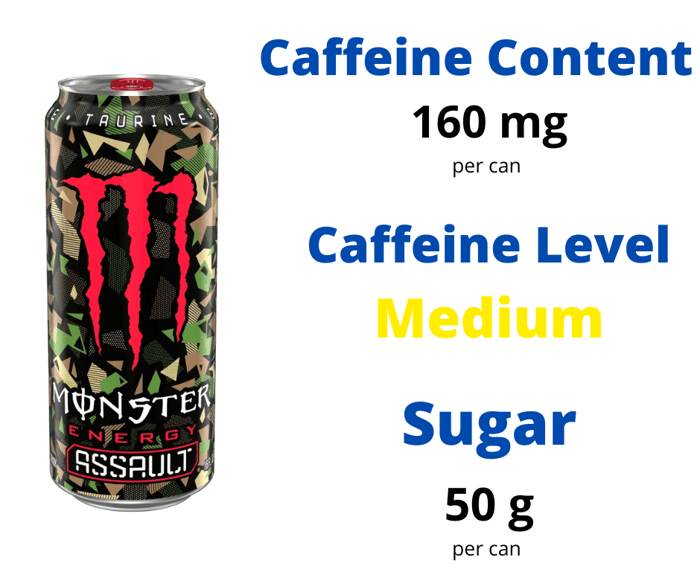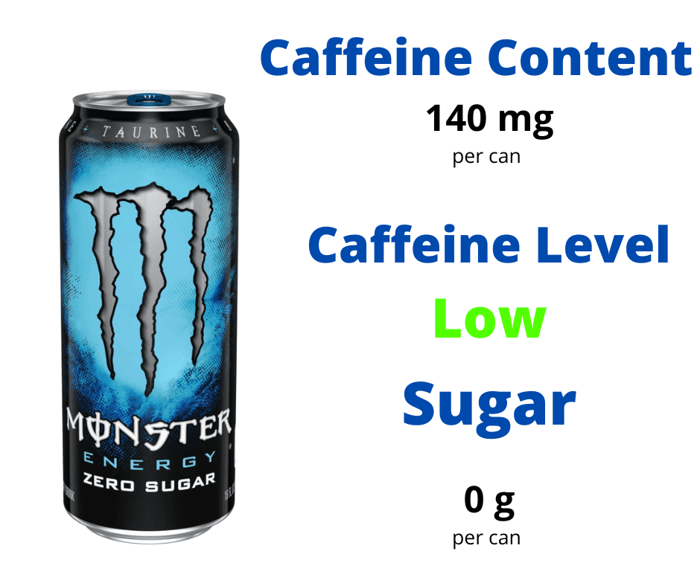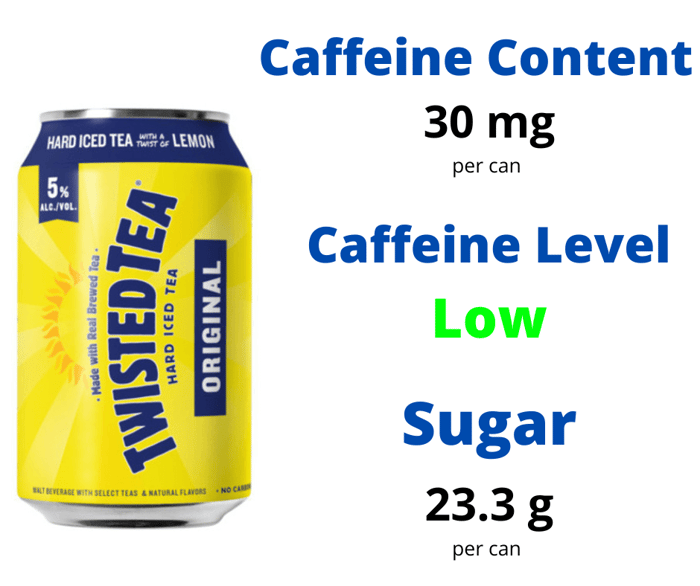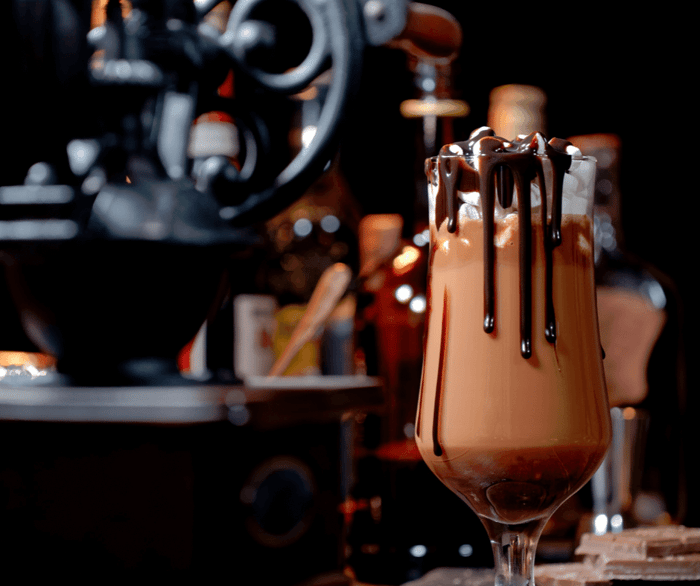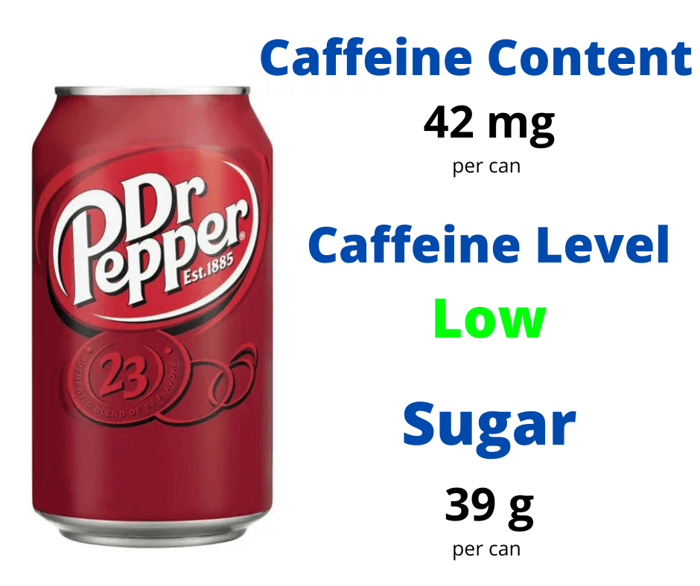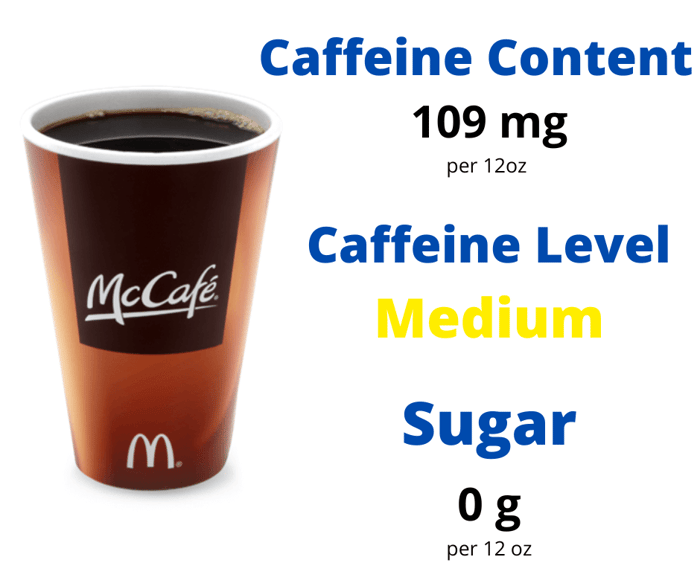The Assault version of Monster Energy Drinks contains 160 mg of caffeine per 16 ounce can or 10 mg per fluid ounce. It comes in a cool looking military style camo can and their website has a tag line we find to be pretty funny. Monster says "We don’t care if you’re right wing, left wing or a chicken wing."
The assault energy drink has a flavor profile of bourbon cola and original monster for a unique twist which combines energy drink and soda.
| Serving | Caffeine (MG) | Sugar (G) |
| 8 Ounces | 80 | 25 |
| 16 Ounces | 160 | 50 |
Is Monster Assault's Caffeine Content Considered High?
At 160 mg of caffeine per can the overall caffeine content would be considered somewhat high but not all that much more than a standard 12oz cup of coffee and is equal to the original Monster.
Where Monster Energy drinks out perform coffee in terms energy is from the stimulant stack added on top of the caffeine. This drink has 500% of your suggested daily value of B12 in just one can.
The FDA's recommended limit for adults is 400mg per day, so while this is considered to be well within the healthy limits, we do not suggest consuming more than one of these daily due to the high stimulant levels and massive amounts of added sugar.
Caffeine can have side effects like nausea and irregular heartbeat if too much is taken at once. Because of this, it's best not to consume more than two cans in a 24-hour period unless you know what you're doing—or else ask your doctor first!
Comparison to other drinks
| Average Caffeine Content | MG of Caffeine |
| Black Insomnia Coffee | 1105 |
| Banned Coffee | 474 |
| Bang Energy | 300 |
|
Monster Energy Assault
|
160 |
| Coke/Pepsi Original | 34 |
Is Monster Assault Sugar Content Considered High?
According to Heart.org, the average adult should consume no more than 30-40 grams of sugar per day. Since a can of Monster Energy Assault has 50 grams of added sugar, the sugar content compared to most energy drinks is considered extremely high. We do not suggest drinking more then one can of this in a daily and ideally limit how often you drink them in general.
One can of Monster Assault has 210 calories.
Ingredients In Monster Energy Assault:

Other Monster Energy Drink Varieties
| Name | Caffeine (MG) | Sugar (G) | Size (OZ) |
| Java Monster 300 | 300 | 32 | 15 |
| Mega Monster | 240 | 81 | 24 |
| Java Monster | 200 | 35 | 15 |
| Monster Import | 179 | 49 | 18.6 |
| Monster Energy | 160 | 54 | 16 |
| Juice Monster | 160 | 46 | 16 |
| Monster Mule | 160 | 52 | 16 |
| Monster Pipeline Punch | 160 | 46 | 16 |
| Monster Reserve | 160 | 28 | 16 |
| Monster Nitro | 160 | 51 | 16 |
| Monster Pacific Punch | 160 | 51 | 16 |
| Monster Assault | 160 | 50 | 16 |
| Papillion | 160 | 48 | 16 |
| Aussie Lemonade | 160 | 46 | 16 |
| Khaotic | 160 | 37 | 16 |
| Monster Dragon Tea | 160 | 23 | 24 |
| Monster Hydro | 160 | 12 | 120 |
| Muscle Monster | 157 | 9 | 15 |
| Monster Mango Loco | 152 | 55 | 16 |
| Rehab Monster | 150 | 3 | 15.5 |
| Monster Ultra | 150 | 0 | 16 |
| Monster Lo Carb | 140 | 6 | 16 |
| Monster Zero Sugar | 140 | 0 | 16 |
| Monster Zero Ultra | 140 | 0 | 16 |
How Long Does Caffeine Stay in Your System?
Caffeine has a half-life of 6 hours, meaning that half of the amount you consumed will be out of your body within 6 hours. The other half will take another 4-6 hours to leave, so that means you'll need to wait 12 hours for complete clearance from your system. But this is just an average; some people may clear it more quickly than others due to individual factors such as age and genetics.
Where to Buy Monster Energy Drinks?:
You can find all of Monster's flavors on Amazon. Take advantage of free shipping for Prime Members.
Want More Coffee Content?
- Daily Coffee Grind - Click Here
- Coffee Reviews - Click Here
- Coffee Brewing Guides - Click Here
- Coffee Brewer Reviews - Click Here
- All Things Tea - Click Here
- Know Your Caffeine Content - Click Here

